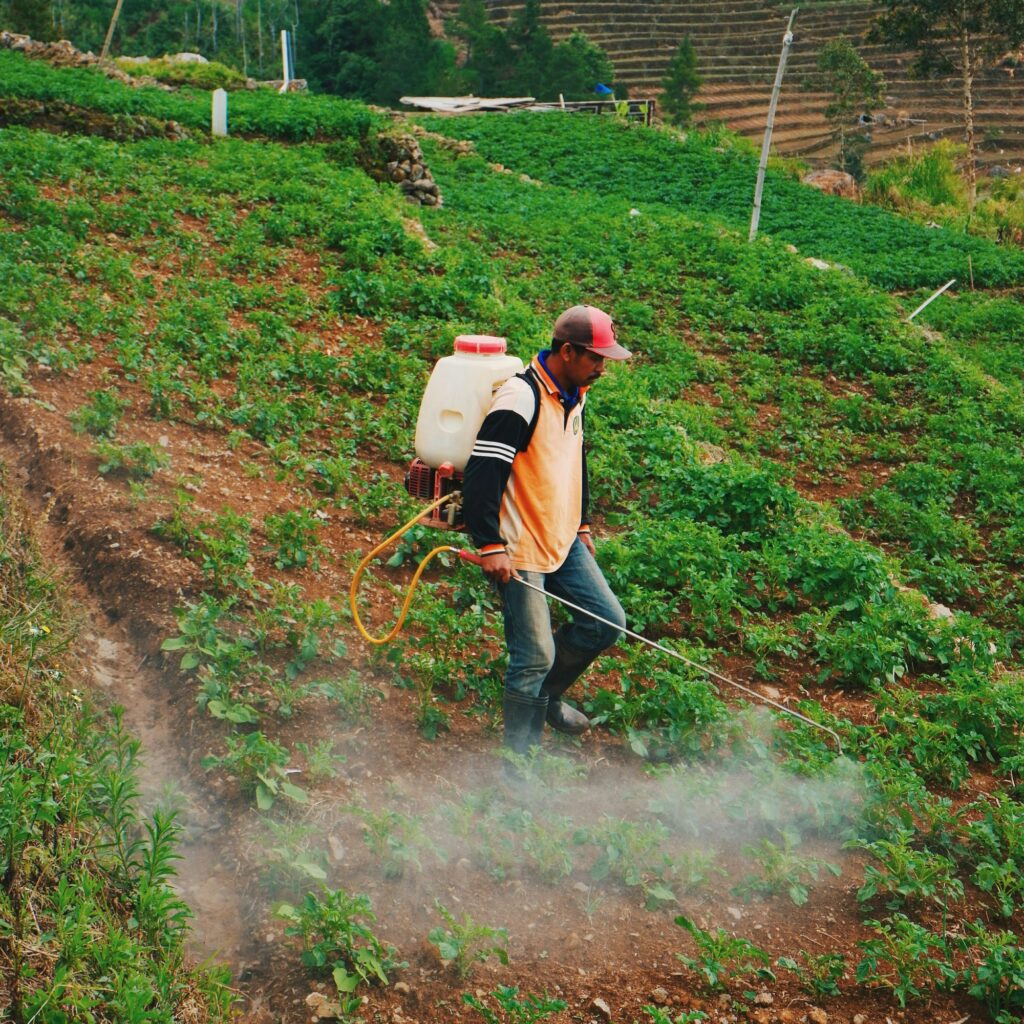
Not long ago, a neighbor came to borrow my knapsack sprayer. It was already midday, the sun high in the sky. Curious, I asked, “When are you spraying?” His answer was quick: “Right now.” He was heading to spray pesticide on his beans in the hottest part of the day.
Scenes like this are common in our villages. Farmers spray pesticides without protective gear, some do it at odd hours, and others handle chemicals with bare hands. While the goal is to protect crops from pests and diseases, these unsafe practices often end up harming the farmer, the environment, and even the effectiveness of the pesticide itself.
This guide will help farmers understand the best time to spray, the protective gear needed, the common mistakes to avoid, and safe handling practices that protect both crops and people.
1. Best Time to Spray Crops
Timing makes all the difference in pesticide effectiveness and safety:
- Early morning (6–9 am) or late afternoon (4–6 pm) are the best spraying times. Temperatures are cooler, the air is calm, and pesticides stick better to leaves.
- Avoid midday spraying. The hot sun causes pesticides to evaporate quickly, reducing effectiveness and increasing the risk of chemical burns to plants and people.
- Don’t spray on windy days. The wind carries chemicals away, wasting your effort and risking your neighbor’s health.
- Don’t spray if rain is expected. Rain washes away chemicals before they can work, wasting money and polluting water sources.
Farmer’s Tip: Think of spraying like applying medicine—it works best at the right time and in the right dose.
2. Protective Gear Farmers Should Use
Your health is more valuable than your harvest. Always wear protective gear when spraying:
- Gloves (chemical-resistant): Protect hands from burns and absorption.
- Mask or respirator: Prevents inhaling dangerous fumes.
- Goggles: Protect eyes from splashes.
- Long-sleeved clothing/overalls: Keep chemicals off your skin.
- Gumboots: Protect feet from spills.
- Hat or cap: Prevents chemicals from dripping onto your face.
Even if gear seems expensive, remember: hospital bills cost more than protective gear.
3. Common Mistakes Farmers Make When Spraying
Many farmers unintentionally put themselves and their crops at risk. Here are the most common mistakes:
- Spraying at the wrong time of day – especially during the hot midday sun.
- Using bare hands to mix or apply pesticides, leading to skin burns and long-term health risks.
- Spraying against the wind, which blows chemicals back onto the farmer.
- Overusing pesticides, thinking more will kill pests faster. In reality, it damages crops, soil, and human health.
- Mixing different pesticides randomly, which can cause dangerous chemical reactions.
- Spraying without reading instructions, leading to misuse and wasted money.
- Reusing empty containers for water, food, or animal feed storage—extremely dangerous for families and livestock.
- Failing to clean sprayers properly, leaving residues that harm the next crop.
Farmer’s Reminder: Avoiding these mistakes can save your health, your money, and your harvest.
4. Safe Handling Tips for Farmers
How you mix, spray, and store pesticides matters:
- Read labels carefully. Follow the instructions for dosage and use.
- Mix in a well-ventilated area. Avoid enclosed spaces.
- Use clean water when mixing.
- Do not eat, drink, or smoke when spraying.
- Wash hands, face, and clothes immediately after spraying.
- Clean sprayers properly after use.
- Store pesticides in a locked, labeled space away from children, food, and animals.
5. Environmental Safety
Unsafe pesticide use doesn’t just harm farmers—it also harms the environment:
- Dispose of containers properly. Never throw them in rivers or use them to store food or water.
- Avoid spraying near water sources. Protect rivers, ponds, and wells from contamination.
- Never overuse chemicals. More pesticide doesn’t mean more protection; it often damages soil and crops.
Conclusion
Spraying pesticides is sometimes necessary for healthy crops, but how and when you do it can mean the difference between safe farming and dangerous farming. Spraying at the right time, using protective gear, avoiding common mistakes, and handling pesticides carefully will protect your health, your family, and your harvest.
As farmers, let’s remember: protecting ourselves is just as important as protecting our crops.

Disclosure: This banner contains an affiliate link. I may earn a commission if you purchase through it, at no extra cost to you.
